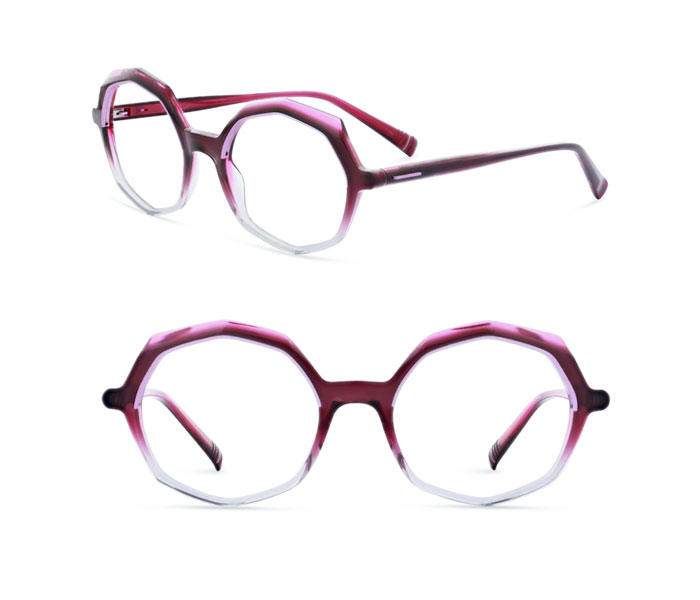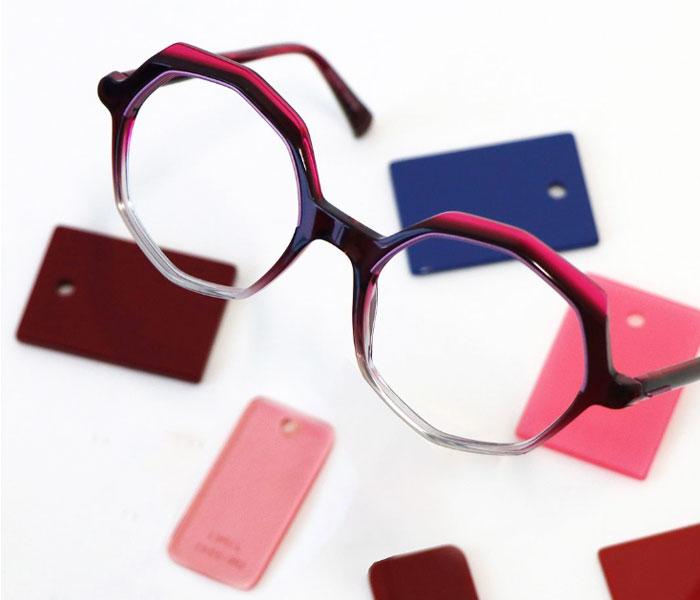Morel s’est inspirée de la couleur Pantone de 2023 : Viva Magenta, pour la conception de 3 de ses nouveaux modèles, 20137K, 40224N et 40203N.
D’après l’institut de la couleur, la PANTONE 18-1750 Viva Magenta accueille tout le monde avec la même envie de vivre et d’esprit rebelle. C’est une couleur audacieuse, pleine d’esprit et inclusive de tout.
Inspirée du rouge de la cochenille, l’un des colorants les plus précieux, les plus forts et les plus brillants appartenant à la famille des colorants naturels, cette teinte électrisante et sans frontières a été soigneusement choisie par des spécialistes qui ont préféré se tourner vers la nature pour y puiser leur inspiration en cette ère marquée par la technologie.
Les modèles 20137K, 40224N et 40203N par Morel expriment ainsi un nouveau signal de force, avec leurs formes et motifs audacieux, leurs collages d’acétate tantôt translucides tantôt opaques, et leurs nuances originales mêlant rose, rouge et violet, pour donner au porteur autant de caractère que de charme.












Thanks for sharing. I read many of your blog posts, cool, your blog is very good.
Ultrasonographic Investigation of Facial Skin Thickness Correlations Between Age, Gender, Body Mass Index, and Anatomical Site
PERMALINK
Ultrasonographic analysis of facial skin thickness in relation to age, site,
sex, and body mass index
Authors
Kyung Muk Jeong, Ji Yun Seo, Anna Kim, Young Chan Kim, Yoo
Sang Baek, Chil Hwan Oh, Jiehyun Jeon
—
### Abstract
This study investigates the relationship between facial skin thickness and various
demographic factors using ultrasonography. We analyzed data from 100 healthy adults to assess skin thickness at different facial sites, considering age, sex, body mass index (BMI),
and other relevant variables. Our findings reveal significant variations in skin thickness across age groups and sexes, as well as correlations with BMI.
These results provide insights into the biological aging process and potential
clinical applications for facial rejuvenation.
—
### Introduction
Facial skin thickness is a crucial indicator of both intrinsic aging and environmental influences.
As individuals age, facial tissue loses volume and elasticity,
often leading to visible signs of aging. Understanding these changes
can offer valuable insights into the mechanisms of aging and potential
therapeutic interventions. This study aims to examine how facial skin thickness varies with age, sex, and other factors like BMI
using ultrasonographic imaging.
—
### Materials and Methods
#### 1. Study population
The study included 100 healthy adults (50 males,
50 females) aged 20–60 years, with a mean BMI
of 22.5 kg/m². Participants were recruited from a university
hospital.
#### 2. Measurement protocol
Ultrasonographic measurements were conducted using a phased-array system
(GE Healthcare, Milwaukee, USA). Skin thickness was measured at six facial sites:
brow, cheek, nasolabial fold, lips, neck, and chin. Each measurement was taken twice to ensure accuracy.
#### 3. Data collection
Demographic data, including age, sex, and BMI, were collected.
Statistical analysis involved comparing skin thickness across age groups, sexes, and BMI categories using regression analysis and correlation studies.
—
### Results
1. **Participants**
The study included 100 participants with a mean age of 35 years (range:
20–60) and BMI of 22.5 kg/m² (range: 18.5–30).
2. **Skin thickness at different facial sites**
– Cheek skin thickness showed significant variation across age groups, decreasing
with advancing age.
– The nasolabial fold thinned significantly with age, while the brow and chin showed less pronounced changes.
3. **Skin thickness and sex**
Males had thicker skin in all regions compared to females (p 0.05).
6. **Skin thickness and other factors**
No significant correlations were found between skin thickness and smoking history or alcohol consumption.
—
### Discussion
The findings highlight that facial skin thickness is influenced by age, sex, and
BMI, with notable variations across different anatomical regions.
The cheek appears particularly sensitive to aging, while the
brow and lips are more influenced by BMI. These results
suggest that biological aging affects subcutaneous tissue composition differently than other tissues.
Furthermore, the relationship between BMI and facial skin thickness may reflect underlying differences in subcutaneous fat distribution.
—
### Conclusion
This study provides novel insights into how facial skin thickness changes with age, sex, and BMI.
These findings have implications for both basic research into aging mechanisms and clinical applications,
such as developing personalized treatments for facial rejuvenation.
Further studies are needed to validate these results in diverse
populations and explore causal relationships between factors like BMI and skin thickness.
—
### Conflict of Interest Statement
No conflicts of interest were reported by the authors.
### Ethics Statement
The study was approved by the institutional ethics
committee and adhered to ethical research practices.
### Acknowledgments
We thank the participants for their contributions and the technical support provided by the ultrasonography
team.
### Data Availability Statement
The datasets generated during this study are available upon request.
### References
None provided in this context.
—
### Associated Data
Data Availability Statement: The datasets generated
during this study are available upon request.
Also visit my web site :: which one of the Following is not a potential danger Of anabolic steroids?
(timurtengah.net)